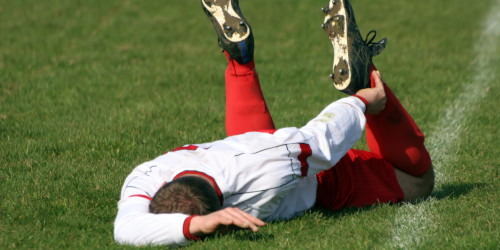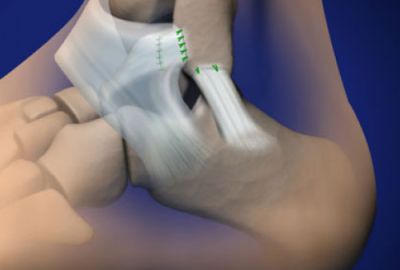- Home
- Foot & Ankle Conditions
- Ankle Sprains and Chronic Ankle Instability
Ankle Sprains and Chronic Ankle Instability
- Published 11/11/2018
- Last Reviewed 3/22/2024
Ankle sprains often occur while participating in sports, walking on uneven surfaces, or just awkwardly planting the foot.
The most frequent type of sprain is called an inversion sprain, which is when the outer ligaments stretch or tear as the foot is rolled outward, with the sole facing in.
Less common is a medial sprain, which is when the foot rolls inward and overstretches the inside ankle ligaments.
- When to see a doctor for an ankle sprain
- What are the symptoms of an ankle sprain?
- How do you diagnose the severity of a sprained ankle?
- What is a high ankle sprain?
- How are ankle sprains treated?
- When ankle sprains turn into chronic ankle instability
- Why partner with UFAI for your ankle treatment?
- Ankle Sprain FAQs
- Should I see an orthopedist or a podiatrist for my sprained ankle?
- Ankle sprain vs ankle fracture, what's the difference?
- How do you prevent ankle sprains?
-
ABFAS® Board Certified in Foot and Ankle Surgery and Co-Director of University Foot and Ankle Institute
Board-Certified Podiatric Foot and Ankle Specialist, Dr. Gary Briskin, DPM, FACFAS, began his medical training by serving a residency at Flint General Hospital in Michigan. Once completed, he established a practice in Century City Hospital, where he soon became chief of podiatric surgery.
Dr. Briskin is a Diplomat of the American Board of Podiatric Surgery and a Fellow of the American College of Foot and Ankle Surgeons. He also serves as an assistant clinical professor at the UCLA School of Medicine and is co-founder and co-director of University Foot and Ankle Institute.
-
ABFAS® Board Certified in Foot Surgery and Reconstructive Rearfoot and Ankle Surgery. and Director of University Foot and Ankle Institute
Dr. Bob Baravarian DPM, FACFAS is a Board-Certified Podiatric Foot and Ankle Specialist. He is an assistant clinical professor at the UCLA School of Medicine and serves as Director of University Foot and Ankle Institute.
Dr. Baravarian has been involved in athletics his entire life and played competitive tennis in high school and college. He has an interest in sports medicine, arthritis therapy, and trauma/reconstructive surgery of the foot and ankle. He is also fluent in five languages (English, French, Spanish, Farsi, and Hebrew),
Read Our Blog Articles About Chronic Ankle Instability
 University Foot and Ankle Institute is an excellent comprehensive facility. Dr. Briskin is a wonderful Doctor and the staff is ...Lisa K.
University Foot and Ankle Institute is an excellent comprehensive facility. Dr. Briskin is a wonderful Doctor and the staff is ...Lisa K. My experience with your practice far exceeded any of my expectations! The staff was always friendly, positive and informative. ...Christy M.
My experience with your practice far exceeded any of my expectations! The staff was always friendly, positive and informative. ...Christy M. Love Dr. Johnson.Emily C.
Love Dr. Johnson.Emily C. I am a new patient and felt very comfortable from the moment I arrived to the end of my visit/appointment.Timothy L.
I am a new patient and felt very comfortable from the moment I arrived to the end of my visit/appointment.Timothy L. Yes we read every commentLawrence H.
Yes we read every commentLawrence H. His is Sandra, Simon’s wife posting. I’m being treated in the Santa Monica location for Achilles tendinitis. The healing is slo...Simon S.
His is Sandra, Simon’s wife posting. I’m being treated in the Santa Monica location for Achilles tendinitis. The healing is slo...Simon S. Everyone is office is fantastic. Thank youDavid G.
Everyone is office is fantastic. Thank youDavid G. Speaking with the doctor was a lot of information at once but I know I’ll have other app ointments before my surgery to be able...Linda D.
Speaking with the doctor was a lot of information at once but I know I’ll have other app ointments before my surgery to be able...Linda D. Keep doing such amazing workAngel C.
Keep doing such amazing workAngel C. The referrals came through quickly and they called me to book an appointment for physical therapy which nobody else does!Catriona D.
The referrals came through quickly and they called me to book an appointment for physical therapy which nobody else does!Catriona D. Good.Lisa E.
Good.Lisa E. I was seen at the Valencia, CA office and Dr. Franson is my podiatrist. He’s done such an amazing job with my foot. I had suff...Trish D.
I was seen at the Valencia, CA office and Dr. Franson is my podiatrist. He’s done such an amazing job with my foot. I had suff...Trish D.
-
 Listen Now
5 Signs your Ankle Sprain Might be a Fracture
Read More
Listen Now
5 Signs your Ankle Sprain Might be a Fracture
Read More
-
 Listen Now
Kids’ Feet and Growth Plates: 5 Problems to Watch For
Read More
Listen Now
Kids’ Feet and Growth Plates: 5 Problems to Watch For
Read More
-
 Why Do So Many Pro Athletes Suffer from High Ankle Sprains?
Read More
Why Do So Many Pro Athletes Suffer from High Ankle Sprains?
Read More
-
 Listen Now
7 Causes of Inner Ankle Pain Revealed!
Read More
Listen Now
7 Causes of Inner Ankle Pain Revealed!
Read More
-
 Listen Now
5 Reasons Why You Have Pain on the Outside of Your Foot
Read More
Listen Now
5 Reasons Why You Have Pain on the Outside of Your Foot
Read More













